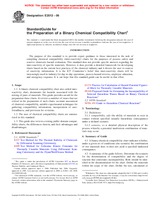Wir benötigen Ihre Einwilligung zur Verwendung der einzelnen Daten, damit Sie unter anderem Informationen zu Ihren Interessen einsehen können. Klicken Sie auf "OK", um Ihre Zustimmung zu erteilen.
ASTM E2012-06
Standard Guide for the Preparation of a Binary Chemical Compatibility Chart
Automatische name übersetzung:
Standard-Leitfaden für die Erstellung eines Binary Chemical Compatibility Chart
NORM herausgegeben am 1.4.2006
Informationen über die Norm:
Bezeichnung normen: ASTM E2012-06
Anmerkung: UNGÜLTIG
Ausgabedatum normen: 1.4.2006
SKU: NS-43950
Zahl der Seiten: 7
Gewicht ca.: 21 g (0.05 Pfund)
Land: Amerikanische technische Norm
Kategorie: Technische Normen ASTM
Die Annotation des Normtextes ASTM E2012-06 :
Keywords:
chemical compatibility chart, inter-reactivity chart, mixing hazards, ICS Number Code 71.020 (Production in the chemical industry)
Ergänzende Informationen
| Significance and Use | ||||||||||
|
Various United States governmental regulations forbid incompatible materials to be transported together and require that chemical reactivity be considered in process hazard and risk analysis. A chemical compatibility chart is one tool to be used to satisfy these regulations. Binary compatibility charts are useful teaching tools in general education, in the chemical plant or laboratory, and for areas and operations where commonly performed tasks might lead to chemical mixtures such as might occur during co-shipment in compartmentalized containers, storage in a common area or compositing waste. Compatibility information is essential during process hazard reviews (for example, HAZOP). These charts may provide guidance to terminal operators on DOT HM-183 that requires that materials on adjacent compartments of multicompartment tank trucks are compatible. They provide documentation that the potential for inadvertent mixing as a potential source of heat and gas evolution from chemical reactions has been considered in sizing relief devices. Compatibility charts serve as check lists for use during process hazard reviews, and the preparation of the chart itself often brings attention to potential hazards that were previously unknown. A binary chart only considers pairs of materials and therefore does not cover all possible combinations of materials in an operation. A common third component, for example, acidic or basic catalysts, may be covered by footnoting the potential for catalysis of a reaction between otherwise compatible materials, but the form of the chart does not ensure this. There may be reactive ternary systems that will escape detection in a binary chart. The AIChE organization Center for Chemical Process Safety (CCPS) has recommended the use of this standard in one of their recent monographs (1). This work is currently available for free download from: http://www.osha.gov/SLTC/reactivechemicals/index.html |
||||||||||
| 1. Scope | ||||||||||
|
1.1 A binary chemical compatibility chart also called inter-reactivity chart, documents the hazards associated with the mixing of pairs of materials. This guide provides an aid for the preparation these charts. It reviews a number of issues that are critical in the preparation of such charts: accurate assessment of chemical compatibility, suitable experimental techniques for gathering compatibility information, incorporation of user-friendliness, and provision for revisions. 1.2 The uses of chemical compatibility charts are summarized in this standard. 1.3 This guide also reviews existing public domain compatibility charts, the differences therein, and their advantages and disadvantages. |
||||||||||
| 2. Referenced Documents | ||||||||||
|
Empfehlungen:
Aktualisierung der technischen Normen
Wollen Sie sich sicher sein, dass Sie nur die gültigen technischen Normen verwenden?
Wir bieten Ihnen eine Lösung, die Ihnen eine Monatsübersicht über die Aktualität der von Ihnen angewandten Normen sicher stellt.
Brauchen Sie mehr Informationen? Sehen Sie sich diese Seite an.




 Cookies
Cookies
